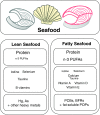Seafood intake and the development of obesity, insulin resistance and type 2 diabetes
- PMID: 30728086
- PMCID: PMC6536831
- DOI: 10.1017/S0954422418000240
Seafood intake and the development of obesity, insulin resistance and type 2 diabetes
Abstract
We provide an overview of studies on seafood intake in relation to obesity, insulin resistance and type 2 diabetes. Overweight and obesity development is for most individuals the result of years of positive energy balance. Evidence from intervention trials and animal studies suggests that frequent intake of lean seafood, as compared with intake of terrestrial meats, reduces energy intake by 4-9 %, sufficient to prevent a positive energy balance and obesity. At equal energy intake, lean seafood reduces fasting and postprandial risk markers of insulin resistance, and improves insulin sensitivity in insulin-resistant adults. Energy restriction combined with intake of lean and fatty seafood seems to increase weight loss. Marine n-3 PUFA are probably of importance through n-3 PUFA-derived lipid mediators such as endocannabinoids and oxylipins, but other constituents of seafood such as the fish protein per se, trace elements or vitamins also seem to play a largely neglected role. A high intake of fatty seafood increases circulating levels of the insulin-sensitising hormone adiponectin. As compared with a high meat intake, high intake of seafood has been reported to reduce plasma levels of the hepatic acute-phase protein C-reactive protein level in some, but not all studies. More studies are needed to confirm the dietary effects on energy intake, obesity and insulin resistance. Future studies should be designed to elucidate the potential contribution of trace elements, vitamins and undesirables present in seafood, and we argue that stratification into responders and non-responders in randomised controlled trials may improve the understanding of health effects from intake of seafood.
Keywords: %E energy percent; AA arachidonic acid; CCK cholecystokinin; CRP C-reactive protein; GLP-1 glucagon-like peptide-1; HOMA-IR homeostasis model of assessment insulin resistance; POP persistent organic pollutant; RCT randomised controlled trial; T2D type 2 diabetes; Body-weight regulation; Fish; Glucose regulation; Marine PUFA; Obesity; Seafood; Type 2 diabetes.
Figures


Similar articles
-
Beneficial effects of long-chain n-3 fatty acids included in an energy-restricted diet on insulin resistance in overweight and obese European young adults.Diabetologia. 2008 Jul;51(7):1261-8. doi: 10.1007/s00125-008-1035-7. Epub 2008 May 20. Diabetologia. 2008. PMID: 18491071 Clinical Trial.
-
A high ratio of dietary n-3/n-6 polyunsaturated fatty acids improves obesity-linked inflammation and insulin resistance through suppressing activation of TLR4 in SD rats.Nutr Res. 2013 Oct;33(10):849-58. doi: 10.1016/j.nutres.2013.07.004. Epub 2013 Aug 9. Nutr Res. 2013. PMID: 24074743
-
Diabetes and branched-chain amino acids: What is the link?J Diabetes. 2018 May;10(5):350-352. doi: 10.1111/1753-0407.12645. Epub 2018 Feb 13. J Diabetes. 2018. PMID: 29369529
-
N-3 long chain polyunsaturated fatty acids: a nutritional tool to prevent insulin resistance associated to type 2 diabetes and obesity?Reprod Nutr Dev. 2004 May-Jun;44(3):289-99. doi: 10.1051/rnd:2004033. Reprod Nutr Dev. 2004. PMID: 15460168 Review.
-
Metabolism and insulin signaling in common metabolic disorders and inherited insulin resistance.Dan Med J. 2014 Jul;61(7):B4890. Dan Med J. 2014. PMID: 25123125 Review.
Cited by
-
Dietary Alaska Pollock Protein Attenuates the Experimental Colitis Induced by Dextran Sulfate Sodium via Regulation of Gut Microbiota and Its Metabolites in Mice.Metabolites. 2022 Jan 7;12(1):44. doi: 10.3390/metabo12010044. Metabolites. 2022. PMID: 35050166 Free PMC article.
-
Metabolic Characterization of Meat, Fish, and Soda Intake in Males: Secondary Results from a Randomized Inpatient Pilot Study.Obesity (Silver Spring). 2021 Jun;29(6):995-1002. doi: 10.1002/oby.23167. Epub 2021 May 3. Obesity (Silver Spring). 2021. PMID: 33938613 Free PMC article. Clinical Trial.
-
Seafood intake in childhood/adolescence and the risk of obesity: results from a Nationwide Cohort Study.Nutr J. 2024 Jul 16;23(1):77. doi: 10.1186/s12937-024-00986-6. Nutr J. 2024. PMID: 39010085 Free PMC article.
-
Study on the Mechanism of the Blood-Glucose-Lowering Effect of Collagen Peptides from Sturgeon By-Products.Mar Drugs. 2021 Oct 19;19(10):584. doi: 10.3390/md19100584. Mar Drugs. 2021. PMID: 34677483 Free PMC article.
-
Health benefits of fish and fish by-products-a nutritional and functional perspective.Front Nutr. 2025 May 9;12:1564315. doi: 10.3389/fnut.2025.1564315. eCollection 2025. Front Nutr. 2025. PMID: 40416371 Free PMC article. Review.
References
-
- US Department of Agriculture & US Department of Health and Human Services (2010) Dietary Guidelines for Americans 2010. Washington, DC: US Government Printing Office.
Publication types
MeSH terms
Substances
LinkOut - more resources
Full Text Sources
Medical
Research Materials
Miscellaneous

